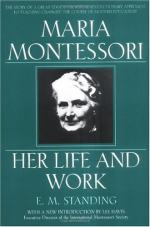
|
| Name: _________________________ | Period: ___________________ |
This test consists of 15 multiple choice questions and 5 short answer questions.
Multiple Choice Questions
1. When given the chance, how does the Montessori method suggest children will function?
(a) As adults.
(b) Chaotically.
(c) Independently.
(d) As a harmonious group.
2. According to Standing, why is joy a surprise to some in terms of this emotion being tied to learning and the Montessori classroom?
(a) Joy is not linked to achievement.
(b) It occurs in traditional classrooms as well.
(c) All children feel joy.
(d) It is a healthy condition.
3. During the time discussed in "Introductory Materials, Preparations & Discovery," what does Montessori discover about those she helped?
(a) They were decipherable.
(b) They were usually rich.
(c) They did not want help.
(d) They could not hear.
4. What profession did Montessori eventually decide to pursue?
(a) International Relations.
(b) Medicine.
(c) Business.
(d) Teaching.
5. During the time Montessori began working, who was making great efforts to understand the mentally ill?
(a) Kennedy.
(b) Newton.
(c) Freud.
(d) Clements.
6. What is the first stage of development, ranging from age 0-6 years, considered?
(a) A stagnant period.
(b) A period of uniform growth.
(c) A period of transformation.
(d) A period of transformation.
7. What does the chapter "Work, Sensorial, Normalcy," state are the pressures adults have in terms of work?
(a) Be 100% correct.
(b) Accomplish all tasks.
(c) Move faster.
(d) Move slower.
8. What does Standing state occurs naturally in children during the learning process?
(a) Incorrect answers.
(b) Frustration.
(c) Repetition.
(d) Satisfaction.
9. Where did Montessori find work after completing her schooling?
(a) Factory.
(b) University.
(c) Insane asylum.
(d) Hospital.
10. When Montessori gave up her medical practice to focus on her teaching, where was she invited a number of times?
(a) Japan.
(b) England.
(c) Asia.
(d) America.
11. Why was Montessori's choice in professions different?
(a) Her parents disapproved.
(b) She was not smart enough for the profession.
(c) She knew nothing about the profession.
(d) There was no female precedent.
12. According to Standing, what does the inner rhythm of the child represents?
(a) Organization.
(b) Chaos.
(c) Mystic.
(d) Musician.
13. In "Exploration, Development," what does Standing suggest is the reasoning some put behind the children's ability to work on their own in a Montessori classroom?
(a) They are simply playing and not learning.
(b) Hypnotic influnce.
(c) Strong discipline.
(d) They are given directions before visitors come in.
14. In "Development," what was unique about what children are able to do in a Montessori classroom in terms of their mistakes?
(a) They are made fun of because of them.
(b) They can correct them.
(c) They are punished for them.
(d) Nothing is done.
15. What is a famous characteristic of the Montessori school?
(a) Children are content doing their work.
(b) Children are very disciplined through the use of rules.
(c) Children have a lot of play time.
(d) There is not direction.
Short Answer Questions
1. According to Montessori, what occurs in terms of deviations, when an adult tries to help a child who does not need assistance?
2. According to Montessori, what are the two streams of development?
3. What type of work does the Montessori school promote?
4. According to Montessori, which of the following is not an indication of the transition form the first to the second stage of childhood?
5. In terms of time, what is first created in the child's mind in order to comprehend time?
|
This section contains 534 words (approx. 2 pages at 300 words per page) |

|




